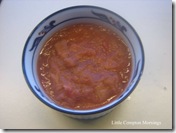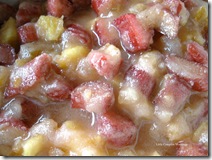 First, the coffee
First, the coffee. I started writing about food on this blog a year ago this weekend, beginning as all my musings about cooking and eating do, in the morning, walking out with my coffee or, when the weather keeps me inside, at the kitchen window. With the exception of a few balmy days, it’s been a cool and breezy—and often rainy—spring after a raw winter, so most of my blog thinking and coffee drinking lately has been the latter. Looking out the window brings its own pleasures, though, particularly for someone like me who likes to observe from the outside (or, in this case, inside). Yesterday I had the treat of watching a mother wild turkey with her russet, energetic baby turkey as they foraged for food and she tried to keep him from plunging into the brush. In recent weeks, seeing a young deer I’d worried about all winter emerge not only alive but getting along well elicited a triumphant hurrah. This deer, one of a family of four, has had one leg severed at the elbow since I first saw him as a tiny fawn—from what? A hunter? Trap? Birth defect? If this three-legged deer can survive, then spring brings hope for us all.
The anniversary of Little Compton Mornings has come upon me suddenly, much like spring always does after a seemingly endless dark winter: you wake up one day and the grass is green, and it’s light when the day is done. Yet while a year seems to have flown by, on closer examination it’s possible to trace the passage of time through events, appointments, holidays, trips, milestones of work and family. It is life, not time, that is going by quickly.
So too with this blog. In the past year, I posted 53 times—one for good measure, I guess, like the extra candle on a cake. I look back amazed: more than 48,000 words and 304 photos (about 15% of those I took). I wrote about coffee, beef, cornmeal, rose hips, berries, vegetables, fish, flour, stone fruits, syrup. I made drinks, appetizers, soups, main courses, side dishes, breads, desserts, and provided the recipes. For someone used to throwing things together, this was a greater discipline even than making sure I did not miss a week of posting (I became religious about this). Sometimes I forgot to record what I was doing as I cooked, and had to reconstruct it. Another challenge was learning to take food photos, still a bit tricky even with a forgiving digital camera. Lesson number 1 (hard learned): turn off the flash.
At first I worried that I would run out of things to write about. Now, I can’t believe I ever thought that, and my real concern is finding the time to write about the things I’d like to—and in particular, to cook and provide well-documented recipes for those things. Cooking takes time, and I have often had to choose something that is not too labor intensive, and reserve those that are (like the
lobster bisque) for special occasions. While I’ve managed a first pass at many classic Rhode Island ingredients and dishes, from
coffee syrup to the debate over jonnycakes (
thick or
thin?), many await discussion in the coming year—the most egregious being, of course, the Trinity.
I’ve tried to look back and assess what
kind of blog I write. This is neither idle navel-gazing nor a conceit: writing always takes on a life of its own. From a technical standpoint, the postings are longer than I expected and than they are for most blogs—the longest was 2092 words or some 8 double-spaced pages—and readers seem to like the depth. Every post carries a recipe. Not sure I knew I was getting into that. From a content standpoint, two things are pretty clear. My blog tends to showcase ingredients in a rather microscopic way—consistent with my notion of seasonality, but not something I had anticipated. And it is squarely in the homey, and home-cooking, category—something I had. For all its hominess, though, it has its characteristically (for me) investigative, information-based side. Part of the pleasure is in the knowing, the considering, the evaluating, the discussing. But not too seriously. Food is, in my blog, part of the conversation of life.
Through all this writing, it is, naturally, my readers that have motivated me. My readers seem to be
readers and
users and do not often comment on the blog itself—although I welcome and encourage that—but many of you have written me wonderful emails so full of appreciation and gratitude that I blushed with pride to read them. I can’t tell you how much this has meant to me as I sit here writing away on my own. I’ve also had the pleasure of meeting a few of you, which has been great fun. Thank you all.
To celebrate our year of Little Compton Mornings, I have made what I always asked my mother to make for my birthday: a pie. It’s too early for berries, and the lemons, a usual fallback, are not particularly nice. Chocolate, however, is always in season.
Anniversary Chocolate Cream Pie
Contrary to popular opinion, the “cream” in cream pie refers to the filling, not the topping. However, this old-fashioned pie can also be made with whipped cream instead of meringue; both are excellent and feel celebratory and indulgent. I depart from my usual lard or lard/shortening crust in favor of an all-butter crust for this pie, both for complementary flavor and for sturdiness beneath the custard filling. Nobody makes this pie anymore—yet men and women alike swoon over it. Let’s mark Little Compton Mornings’s anniversary by bringing it back.
Serves 6.
The All-Butter Crust 
This needs to be blind-baked, so plan ahead.
1 ½ cups a-p flour
2 T sugar
1/8 tea salt
4 oz (1 stick or ½ cup) cold unsalted butter, preferably cultured, high- butterfat
(sometimes called “European style”)
3-5 T ice water
1 T heavy cream
Put the dry ingredients into the food processor with the metal blade. Add the butter, cut into at least 8 pieces. Pulse 15-20 times, until the mixture is crumbly but not so fine as to be sandy. With the motor running, add 3 T of the ice water and the cream, then add the remaining water gradually and stopping as soon as the dough comes together. Remove, pat gently into a disc, and refrigerate for an hour or overnight.

Preheat the oven to 425 F. Let the dough soften a bit and then roll it out on a floured board to 1/8” thick. Fit it comfortably into a 9” pie plate, trim and turn under the rim, crimp the edge, and prick the bottom and sides with a fork. (You can re-roll the scraps and make little turnovers filled with blackberry or other jam for baking with the pie crust and then sprinkling with sugar for a cook’s treat.) Chill the crust for an hour in the refrigerator or 20 minutes in the freezer.
Place a piece of foil inside and fill with dried beans, rice, or aluminum pie weights. Bake for 10 minutes; reduce the heat to 350 F and bake 10 minutes more. Lift out the foil and weights and bake until golden and crisp, about 5-10 minutes more.
The Chocolate Pudding
1/3 cup flour
2/3 cup sugar
Pinch salt
2 ¾ cups milk, heated to steaming
2 squares unsweetened chocolate
3 extra-large egg yolks

1 tea pure vanilla extract and 1 tea pure chocolate extract, or 2 tea vanilla
1 T unsalted butter
Combine the dry ingredients in a 3-qt saucepan, preferably one with sloped sides. Using a whisk, gradually stir in the milk over medium heat. Add the chocolate and whisk continuously; the mixture will amalgamate and then thicken. It should bubble gently. Cook 5 minutes more.
Remove the pan from the heat. Beat the egg yolks in a spouted cup or small bowl. Remove about ¼ cup of the chocolate mixture and stir it into the yolks until well blended; Add the tempered yolks to the pan. Return to the heat and cook, stirring, for another two minutes. Remove from the heat and stir in the extract(s) and the butter. Set aside for half an hour, covered with a piece of plastic wrap.
The Meringue
3 extra-large egg whites
6 T sugar
Pinch salt
Beat the egg whites with the salt ‘til foamy, then gradually add the sugar, continuing to beat until they are very white, shiny, and thick, and form a beak when the beater is lifted. Be careful not to overbeat.
Finishing the Pie
Preheat the oven to 425 F. Pour the slightly cooled pudding into the pre-baked pie shell, rotating the plate to spread it; use a flat offset spatula or back of a spoon if necessary. Pile the meringue
very gently onto the pudding, ensuring it overlaps the edge of the pie shell. Bake about 6-8 minutes, or until lightly golden. Cool to room temperature before serving (it is ethereal served this way, fresh). Refrigerate leftovers.
 _____
To those of you who took the time to vote for me in Best of Rhode Island, thank you for your support.
It’s come to my attention that some of you who have email subscriptions may not be receiving all your weekly emails. Please check your spam folder, and if you find Little Compton Mornings there, flag it as O.K. for your Inbox. If that is not the problem, try re-subscribing.
_____
To those of you who took the time to vote for me in Best of Rhode Island, thank you for your support.
It’s come to my attention that some of you who have email subscriptions may not be receiving all your weekly emails. Please check your spam folder, and if you find Little Compton Mornings there, flag it as O.K. for your Inbox. If that is not the problem, try re-subscribing.
 My fondness for sour milk in baking, as expressed here , here, and here, extends to its close relative, buttermilk. The buttermilk available to us in stores is “cultured” buttermilk, which is different from what I would call “true” buttermilk—the milk or liquid that remains after butter is churned. Some of you may remember this kind of buttermilk from your youth. It was about the consistency of today’s skim milk, was quite acidic, and often had tiny flecks of butter in it. It was a natural low-fat product.
My fondness for sour milk in baking, as expressed here , here, and here, extends to its close relative, buttermilk. The buttermilk available to us in stores is “cultured” buttermilk, which is different from what I would call “true” buttermilk—the milk or liquid that remains after butter is churned. Some of you may remember this kind of buttermilk from your youth. It was about the consistency of today’s skim milk, was quite acidic, and often had tiny flecks of butter in it. It was a natural low-fat product.
















